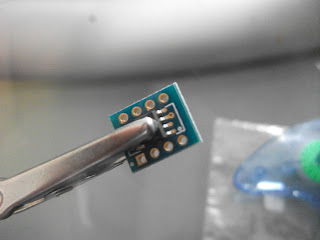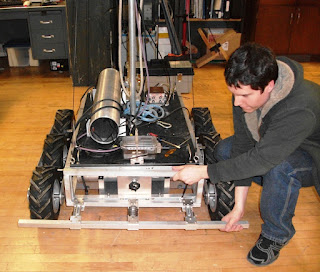
Modifications
So far I only changed two things from the basic design you can get from github. Most of the links I used, including the supplier for most of the parts are at the bottom of this page (Reprap wiki page for kossel mini). One thing I changed was the carriages. The square peg didn't seem to grip the belt well, so once it was closed using a zip tie it naturally rotated to come off the middle of the peg.
I used this Carriage on Thingiverse by user Pierre233, I added some notches so I could still cinch down the belt plates with a zip tie. My goal was not to eliminate the zip tie, but to put a guide in place to keep the belt straight. I will upload those files with the update when my printer is all finished, since the design could still use some tweaking.
The other change was a machined aluminum print bed, since I want to eventually make it heated. I've countersunk the holes since this picture was taken so that those screws can't get in the way. I'm working on a design to support the bed on an insulating spacer. The screws will still conduct some heat out, but not enough to damage anything or keep the plate from getting warm.
Controller
I went with a Ramps 1.4 board since it is one of the best documented and easy to add things on to. It is running DRV8825 motor drivers, not the more common A4988 ones from pololu. I did this because I want to keep them cool without a fan so I can eventually put the driver board underneath the bed, giving the whole printer a very neat look. This did require adjusting the firmware to use a steps/mm based on a 32 microstep board, A4988 drivers do 16.
The drivers do indeed stay cool. I tuned them to 1.2A, which is what my motors require, the guide to do so is on pololu here (Pololu Driver Page). However the motor squeal is pretty annoying, I've ordered some A4988 drivers to see if it helps. I figure it may be the PWM frequency they use.
Framing
I printed the parts out on a Taz that a friend of mine owns, I didn't have ABS so most of it is PLA. Except for the end effector mount, that might take some heat, and I did have a little bit of pink ABS, so I printed it from that and painted it yellow.
The frame pieces came from Misumi, it saved a little compared to other sources, the total was $42.22. That's 33.12 for the 9 beams 240mm type HFS3-1515 and the 3 beams at 600mm, plus $1.85 tax and $7.25 shipping, and it got here in 4 days. Pretty good.
Movement
For linear rails I searched all over for a salvage source here in the US and eventually had to go through aliexpress. It was $91 and took about a week. They are of nice quality, and for me the extra cost of going with recirculating ball rails is worth it (about $30 more than using v rollers). They look cooler and they are more precise. If I'm going to take the time to build it I figure I'll get the best components I can.
The belts, pulleys, rods and links are all from the same place. (Kossel Parts List)
Hot End
Speaking of quality, the hot end is a J-head straight from the inventor (Hotends.com) since the extruder is the part that seems to fail the most on 3D printers in general I would advise against going with a knock-off to save $30, unless your time is worth less than $3 an hour.

Extruder Drive
I used an Airtripper Bowden extruder (Airtripper files and instructions), I went with rubber hose for the compression as he suggests, and at the Milwaukee Makerspace I found a bearing of the right size, and with a little round groove in it right where the filament needs to go. It works great. When I built it I didn't have the right size tap so I just used a 10-32 screw.
Tuning
I found the information in this blog very helpful (http://minow.blogspot.com/). Basically, you adjust the bed and the endstops to get it level, which you can test by moving equal distances off center and measuring. Then you get the curvature flat, which you measure by going between the center and equal distances from the center and checking the height. For this you will need to adjust the delta radius, which is best adjusted by changing it's inputs. I picked DELTA_SMOOTH_ROD_OFFSET and went through a few cycles of measuring at the middle and 60 mm off center and recording the effect it had. I've gotten a depth gauge but at the time I actually just wrote down how many pieces of paper fit under the nozzle and dialed it in, and it worked fine.

Once you get the curvature down, you can adjust the rod length to get the scale right, I had already measured my rods with a caliper and once the curvature and leveling was done, the first print came out right on scale (see below) so I left that alone.
 |
| Full Disclosure, I hunted around a bit to get exactly 25.00mm, it ranged by about 0.07mm. Close enough for me. |
This part came out pretty smooth too, I did see a little bit of stranding on the bridges. I've tested it at 0.1mm layer height and haven't had a jam yet, which I'm very happy with since I often see printers having trouble with fine resolution and I had my doubts about pushing the filament through a tube.
Next I'm working on some feet to lift it up a bit, a heated bed and mounts for the control electronics underneath. Also I'll post those carriage files.




























